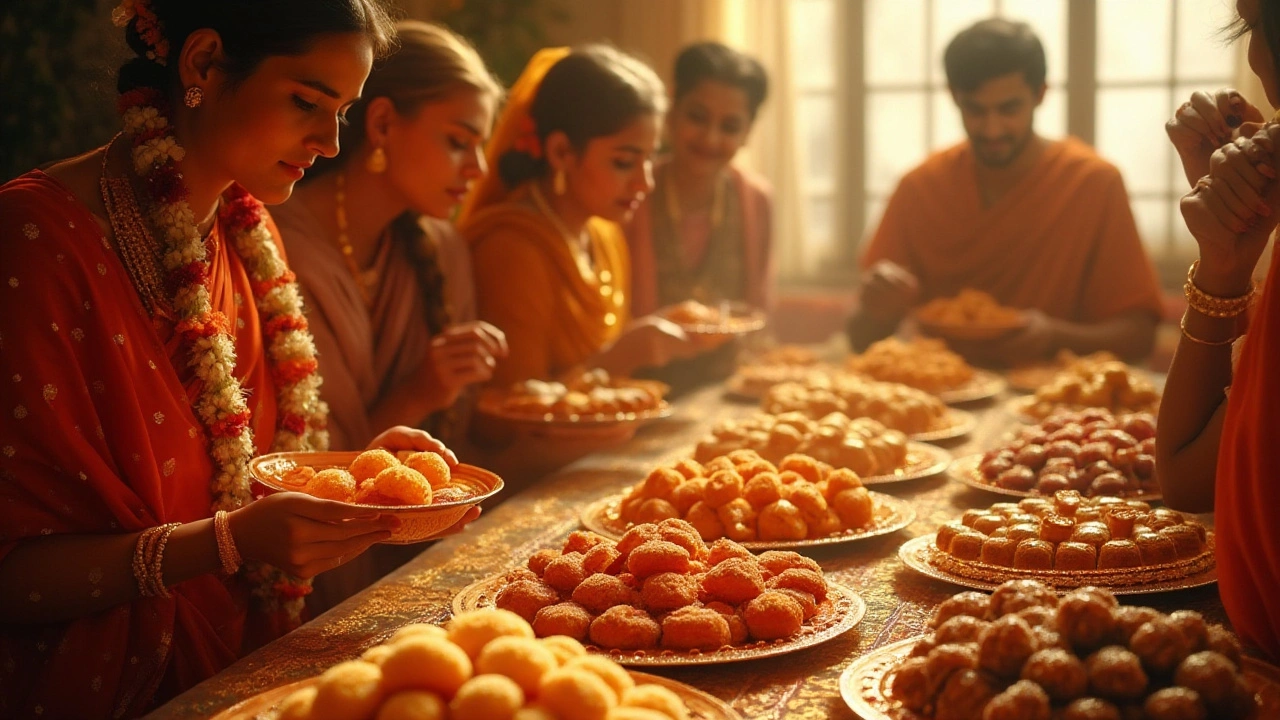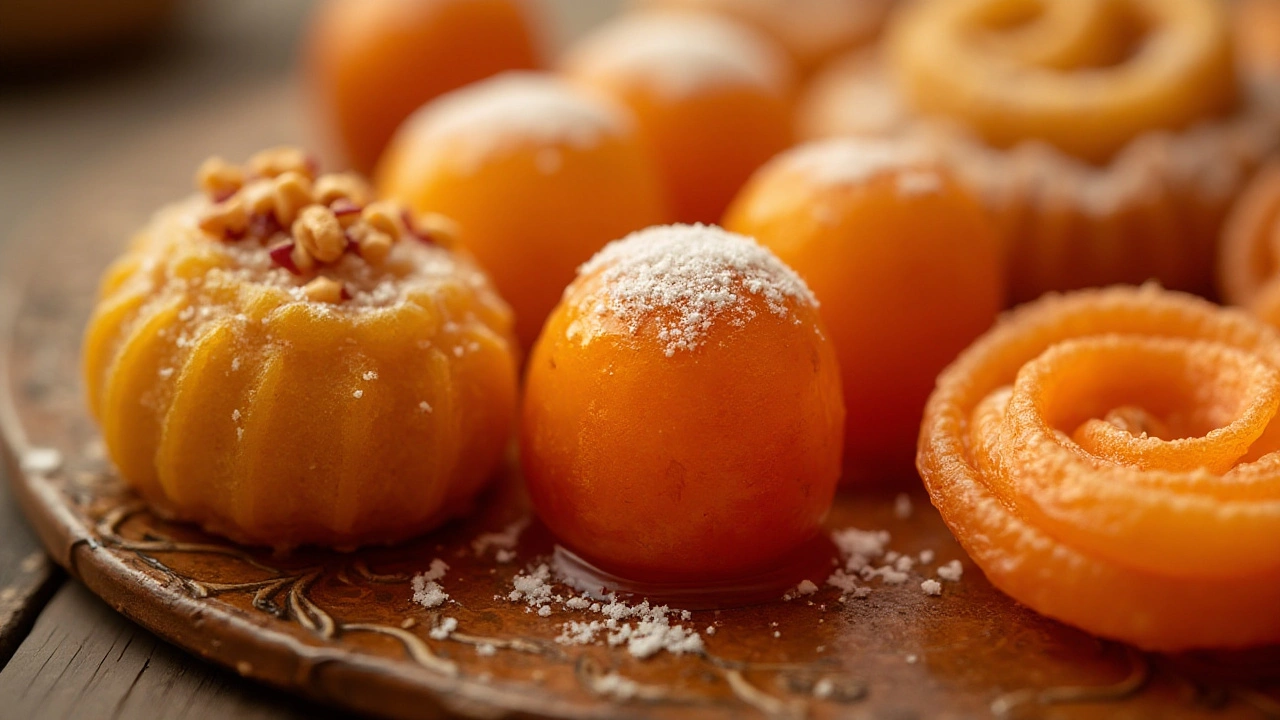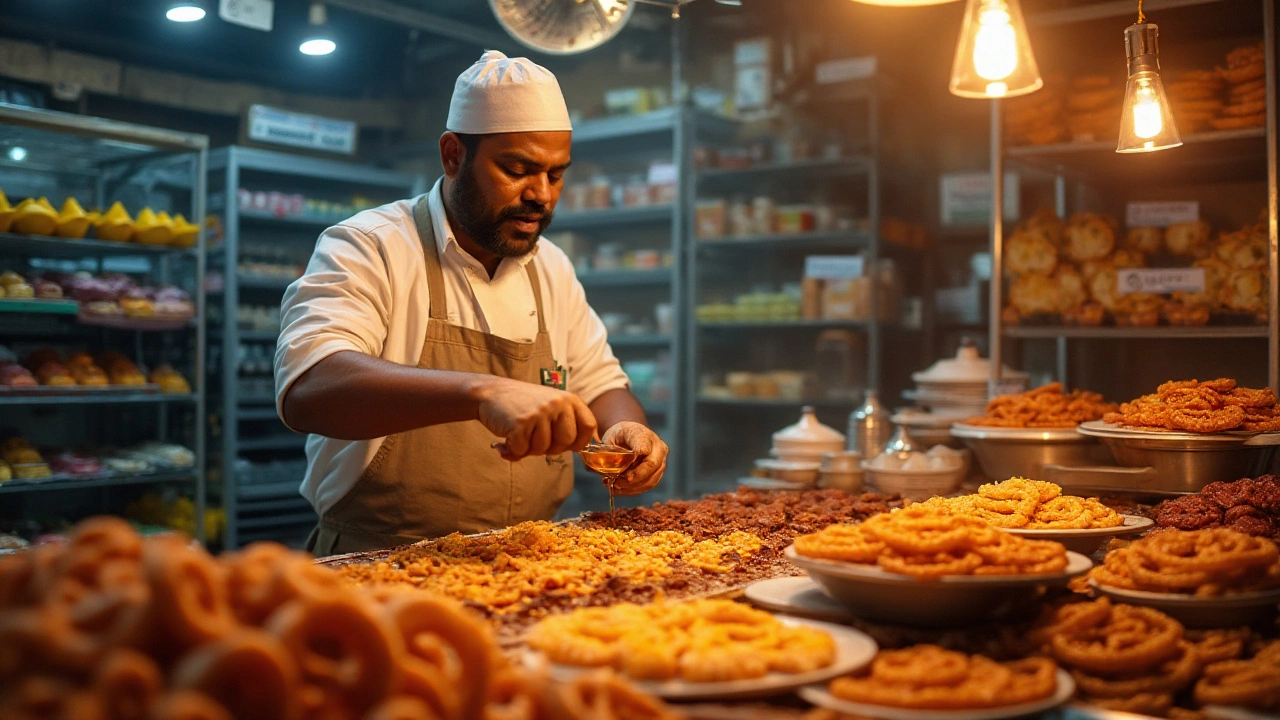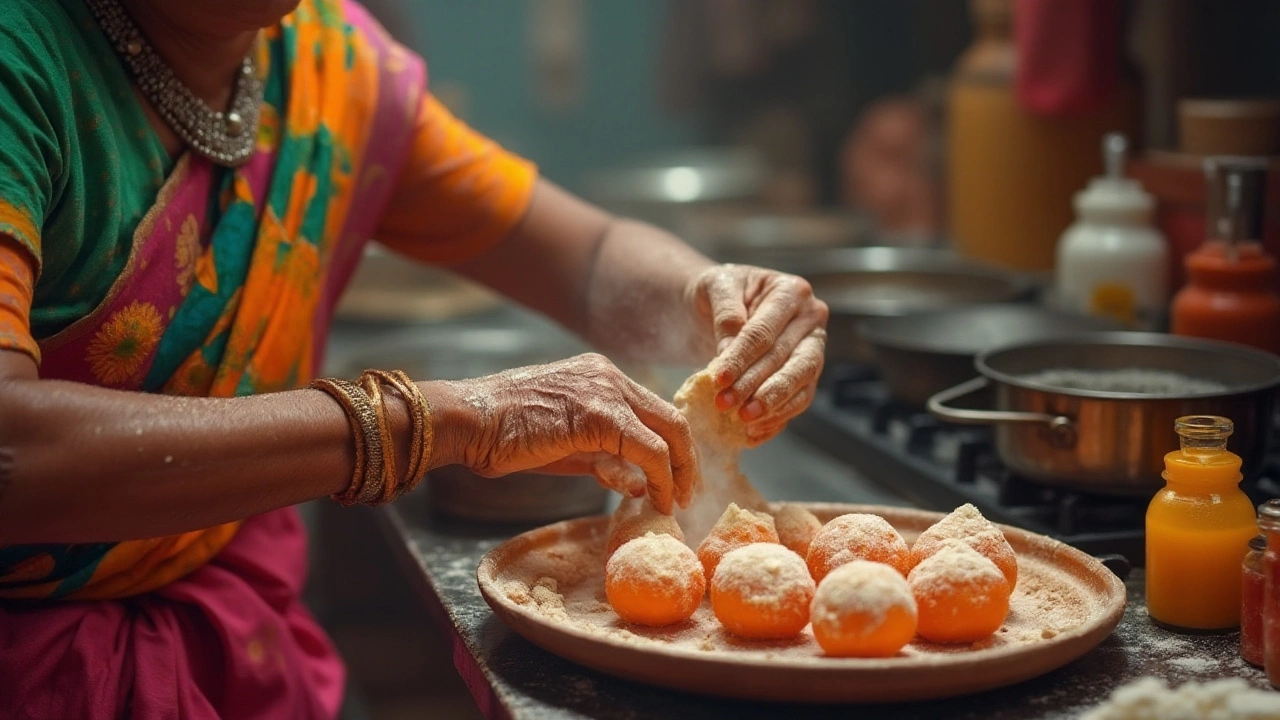30 Nov 2024
- 0 Comments
Indian sweets, or 'mithai,' are as diverse as the country itself, offering a plethora of flavors and textures that entice the senses. At the heart of many Indian sweets, you'll find sugar—acting not just as a sweetener but as a crucial component that brings stability and consistency to each creation.
This staple ingredient weaves its way through countless recipes, enhancing everything from the creamy smoothness of burfi to the syrup-soaked delight of rasgullas. But sugar doesn't work alone; it's paired with a variety of ingredients, each adding unique qualities exclusive to different regions of India.
Mastering the art of Indian sweets means understanding the chemistry of sugar and its synergetic relationship with other staple ingredients like milk, flour, and nuts. Whether you're preparing sweets for a festive occasion or simply indulging your culinary curiosity, discovering the role of sugar in Indian sweets opens up a world of delightful possibilities.
- The Sweet Spectrum and Sugar's Role
- Types of Indian Sweets
- Regional Variations and Ingredients
- Tips for Making Indian Sweets
The Sweet Spectrum and Sugar's Role
As one dives into the enchanting world of Indian sweets, it's impossible to ignore the pivotal role that sugar plays in crafting these delectable treats. This ubiquitous ingredient is the cornerstone of almost every dessert found across India's diverse culinary landscape. Far from being just a sweetener, sugar contributes to the texture, stability, and even shelf-life of these sweets, transforming simple ingredients into indulgent delights that have been enjoyed for generations.
Sugar is not merely the substance that sweetens; it is integral to the alchemy of cooking that turns milk into fudgy peda, powders into crumbly ladoos, and dough into lazily floating gulab jamuns. The amount and type of sugar used can vastly change the sweetness level and texture of the final product. Refined white sugar, jaggery, and even palm sugar are some of the variants that influence the final taste, color, and health quotient of the sweets. This variety in sugars gives rise to an astonishing array of flavors, each with its unique appeal depending on the region and season.
For instance, the iconic sweet of Bengal, the rasgulla, relies heavily on its syrupy sugar solution to keep the balls of chenna soft yet firm to the bite. The syrup needs to have the right consistency, and this is meticulously achieved by understanding the delicate balance between the sugar and water content. These nuanced relationships between ingredients are what make Indian confectionery a mesmerising study in culinary chemistry.
A well-crafted sweet can evoke powerful memories and connections to one’s heritage. As noted by food historian K.T. Achaya, "Sweets are much more than culinary delights; they are a thread that connects the narratives of the country's rich past to the present."
The role of sugar extends beyond taste – it also creates layers in sweets, something especially notable in flaky layered mithais like sohan papdi. The stages of sugar cooking, from soft ball to firm crack, determine how certain sweets break or hold together. This subtle mastery ensures that each confection holds its intended texture even under the humid conditions that prevail in many parts of India.
Different Sugars, Different Results
From the snowy peaks of the Himalayas to the tropical coastlines, various types of sugars are employed, each bringing a new depth of flavor. Jaggery, for instance, brings a deep, molasses-like richness to sweets and is often preferred in the southern and western parts of India. Its earthy sweetness not only enhances the taste but also adds a nutritional benefit due to its mineral content found in its less refined form. Conversely, refined sugars provide the pristine appearance and clean, unadulterated sweetness sought in northern delicacies like barfi.
Using tables to illustrate, here’s a small example of sugar’s diverse application across India:
| Sweet | Key Ingredient | Sugar Type |
|---|---|---|
| Rasgulla | Chenna (Cottage Cheese) | Refined White Sugar |
| Gulab Jamun | Khoya (Dried Whole Milk) | White Sugar Syrup |
| Chikki | Nuts/Sesame | Jaggery |
For an aspiring sweet maker, understanding the role of sugar is as exciting as it is essential. By experimenting with the amount and type of sugar, one can tweak the balance of flavors and textures to create sweets tailored to individual preferences. Sugar, in its various forms, truly is the magic wand in the sweet spectrum of Indian cuisine.

Types of Indian Sweets
India's culinary landscape is rich with sweets, an array of delightful treats that bring joy to every occasion. From northern to southern realms, each region of India takes pride in offering its own signature Indian sweets, influenced by local ingredients and traditions. Let’s dive into a fascinating exploration, where the magic of sweets like ladoos, halwas, and jalebis takes center stage, thrilling the hearts and taste buds of sweet lovers everywhere. In Rajasthan, for instance, the beloved ghewar—a disc-shaped delicacy—is crafted with flour, sugar, and clarified butter. Its porous texture is often crowned with chopped nuts and saffron, showcasing how simple ingredients yield intricate flavors.
Moving to Bengal, the art of sweet making turns into a fine craft, with sweets that have humble origins turning into sophisticated delights. Take rasgulla, for instance, a cherished part of Bengali culture. These spongy, syrup-filled gems are made from fresh paneer, also known as chenna, boiled in sugar syrup to keep their juiciness intact. Kolkata brims with shops specializing in these sweet orbs, each offering its own twist. In fact, the rasgulla is so integral to Bengali identity that it was awarded the Geographical Indication (GI) tag in 2017, certifying its origins.
The North and the Charm of Ghee
The northern regions of Punjab and Uttar Pradesh indulge in their love for sweets through the generous use of ghee (clarified butter) and mawa (reduced milk), both key elements of their distinctly rich and flavorful confections. Think about the vibrant ladoos, made during festive times. Each bite of this iconic sweet—whether it be besan, boondi, or motichoor ladoo—offers a taste of tradition wrapped in wholesomeness. Mawa based sweets like barfis and pedas continue to be perennial favorites among Indians and foreigners alike.
"The celebration of sweets is deeply ingrained in the Indian psyche, indicative not just of gastronomy but of cultural expression," notes K.T. Achaya, an Indian food historian.
In Tamil Nadu, a festival isn’t complete without the renowned sweet pongal, a festive delight made using rice, jaggery, and lentils, simmered slowly to create a warm and comforting dish. The addition of cardamom, cashews, and raisins gives it the layered complexity that people cherish during Pongal festival celebrations. This type of sweet is a beautiful representation of the holistic use of local ingredients and time-honored traditions.
From festive preparations to everyday indulgence, Indian sweets not only satiate hunger but also strengthen bonds. As you journey through these sweets, where even the humblest of ingredients like sugar or milk explode into extravagant flavors, you will discover the cultural patchwork that makes India so diverse and enchanting. Making sweets at home allows one to partake in culinary traditions that stretch back generations, while adding a personal twist to every creation.

Regional Variations and Ingredients
India is a land of diversity, and Indian sweets reflect this richness with their regional variations and the distinctive key ingredients used across the subcontinent. Each state boasts its own specialty sweets, borrowing from local agricultural produce, spices, and tradition. For instance, the northern states, famous for their lush dairy farms, boast sweets made with rich ghee and loaded with flavorful nuts. Think of the scrumptious kalakand or the ever-popular kaju katli, both harmonizing the creaminess of milk with the sweetness of sugar, creating a sumptuous melt-in-the-mouth delicacy.
Meanwhile, down in southern India, sweets like Mysore pak or coconut barfi showcase the region’s infatuation with ghee and coconut. The use of jaggery, an unrefined sugar, is common and adds a distinct earthy sweetness and chewy texture. This is juxtaposed with coastal areas that prefer using coconut milk and tropical fruits to enhance the local palette, offering a distinctly different but equally compelling taste. West Bengal, known for its mastery of desserts, delights with the iconic rasgulla and sandesh, both emphasizing a fresh cheese base to accentuate its unique taste. As Suman Sinha, a renowned Bengali chef, says,
"Each sweet in West Bengal tells a story of its own, influenced by the geographic and cultural backdrop of this vibrant region."
Moving to the western belt, Maharashtra’s puran poli captures the essence of the state with its use of chickpea flour and jaggery—a delightful play of tastes that emphasizes their traditional offerings. Gujarat celebrates with sweet treats like shrikhand, characterized by its use of saffron and cardamom, providing an aromatic touch that makes it irresistible. Not to be left behind, Rajasthan offers an array of toothsome delights such as ghevar, a sweet that mirrors the harsh desert climate with its hardiness yet delivers a sweet and soft center coated in sugary syrup. This geographic exploration highlights how each region's food culture and available resources heavily influence their sweet recipes, proving that while sugar might bind them, the diversity of their key ingredients brings the magic that spreads festive joy across homes and hearts.
| Region | Popular Sweet | Key Ingredient |
|---|---|---|
| North India | Kalakand | Milk and Sugar |
| South India | Mysore Pak | Ghee |
| West Bengal | Rasgulla | Cottage Cheese |
| Maharashtra | Puran Poli | Jaggery |

Tips for Making Indian Sweets
Embarking on the journey of crafting Indian sweets can be both intriguing and rewarding. The process often involves mastering traditional techniques that have been passed down through generations. To begin, understanding the type of sweet you wish to make is crucial, whether it's the syrupy gulab jamun or the flaky and layered Mysore pak. Each requires a distinct approach. For instance, gulab jamuns require carefully preparing the dough and frying it to a perfect golden brown before soaking in a fragrant sugar syrup. The balance in the syrup's consistency is critical, as too thick can prevent absorption, while too thin results in a soggy finish.
Another important aspect is the quality of ingredients. Fresh, high-quality milk products like khoya or paneer make all the difference in the taste and texture. Traditional recipes, like peda or barfi, rely heavily on the creamy richness these dairy elements provide. Make sure to use pure ghee instead of oils or other substitutes, as ghee imparts an authentic aroma and flavor that is irreplaceable. Cooking over a low flame, with constant stirring, helps in achieving the desired consistency without burning the mixture.
Sugar is undeniably the hero of many recipes, but its usage isn't always straightforward. The type of sugar, whether it's refined white, unrefined brown, or even jaggery, can alter the dish significantly. Light golden syrups or darker, robust ones like made with jaggery are often preferred for their deeper flavor profiles. Rakesh Sharma, a notable Indian culinary expert, once said,
"The beauty of Indian desserts lies in their simplicity. Attention to the sugar's character can transform a good dish into a great one."
If you're working with nuts or exotic spices like cardamom and saffron, toast and grind them fresh to heighten their aromas. These additions not only contribute to the sensory appeal but also bring a nutritional touch. Timing is key, as certain sweets like jalebis are best made and consumed fresh, while others like laddoos taste better with a day or two to develop their flavors. Proper storage in airtight containers ensures they maintain their freshness and taste.
Knowledge of local substitutes can be helpful, especially if you live away from India. Products such as coconut milk or soy milk can substitute for cow’s milk, while syrupy alternatives like maple or agave can occasionally stand in for sugar, though they offer a unique twist on tradition. Experimenting while adhering to core techniques could lead you to invent a personalized version that's just as delightful as the classic. Remember, practice and a bit of patience are your best tools when crafting these delightful indulgences.
